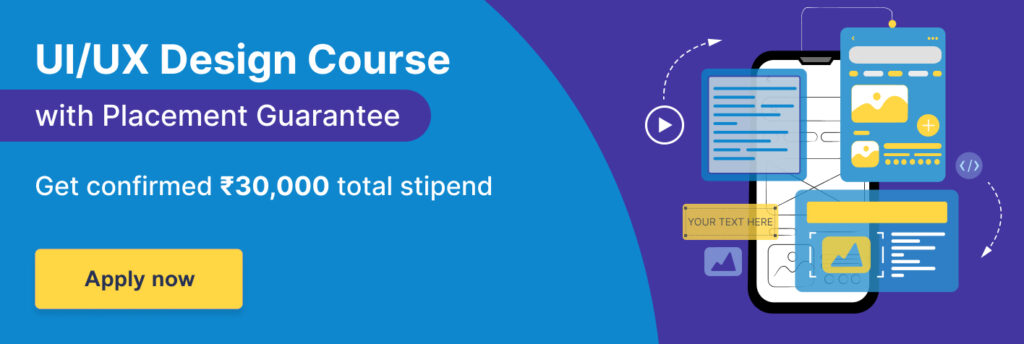UI/UX Designer Skills: Technical & Non-Technical Skills
From social media to e-commerce, the user interface (UI) and user experience (UX) of websites and apps have become paramount in captivating and retaining the attention of today’s digital audience. In a competitive digital landscape, organizations invest in exceptional UI/UX design to ensure their products and services stand out.
As a result, the demand for skilled UI/UX designers has skyrocketed, making it an enticing career path for individuals passionate about creating delightful and intuitive digital experiences. This blog will explore UI/UX designer skills, roles and responsibilities, and the job outlook in both domains.
Introduction to UI/UX
UI and UX design are essential for creating visually appealing, easy-to-use products and services that provide a positive user experience. By combining these disciplines, designers can create interfaces that are not only visually attractive but also intuitive and efficient for users. Let’s understand them in more detail.
UI Design
UI, or User Interface, focuses on the visual and overall aesthetic aspects of a website, app, or digital product. The main goal of UI design is to create an appealing, easy-to-navigate interface that allows users to interact with the product effectively. It includes elements, such as layouts, colors, typography, buttons, and icons.
UX Design
UX, or User Experience, is all about enhancing the overall experience of users while interacting with the digital product. It involves understanding user needs and expectations and improving the product based on feedback and user behavior.
UI/UX Designer Skills
UI/UX design is a multidisciplinary field that requires a diverse range of skills to create exceptional user experiences. Technical skills equip UI/UX designers with the necessary UI tools and UX tools to create visually appealing and user-friendly designs, while non-technical skills enable effective communication, problem-solving, and collaboration within a team. Let’s explore the key technical and non-technical skills that UI/UX designers should possess in order to excel in this field.
Get a confirmed ₹30,000 total stipend and secure your future with the UI UX design placement guarantee course today!
UI/UX Designer Technical Skills
Let us look at the table below to explore these skills in detail:
| Skill | Description |
| Expertise in UX Research | UX research provides insights for informed designs. It involves planning research studies, selecting participants, and using usability testing techniques. |
| Wireframing & Prototyping | Wireframes are low-fidelity, visual representations of layouts, used in early development stages to establish the design structure. |
| UX Writing | UX writing includes all text in designs, such as button labels and error messages, ensuring users navigate designs effortlessly. |
| Visual Communication | Visual communication helps convey information clearly, concisely, and engagingly, forming an essential part of UI/UX design. |
| Basic Coding Skills | While not mandatory, understanding HTML, CSS, and JavaScript helps designers create prototypes and collaborate effectively with developers. |
| Typography | Proper typography conveys emotions, establishes hierarchy, and guides users through designs using appropriate fonts and typefaces. |
| Interaction Design | This involves designing user-friendly interfaces with menus, buttons, and navigation systems for engaging user experiences. |
| Analytical Abilities | Analytical skills help designers collect and interpret data from surveys, user testing, and analytics tools to make data-driven design decisions. |
| Information Architecture | This skill involves organizing, structuring, and labeling content to create logical hierarchies, enhancing accessibility and functionality. |
| SEO & Social Media | Understanding SEO ensures websites are search-engine-optimized, while social media insights help align designs with user expectations and marketing strategies. |
In order to learn more about UI and UX design consider taking a UI and UX design course.
UI/UX Designer Non-Technical Skills
Non-technical skills are essential for UI/UX designers to communicate effectively, collaborate with teams, and adapt to project demands. These skills ensure smooth workflows, creative problem-solving, and user-centered design outcomes.
Let us look at the table below to explore these skills in detail:
| Skill | Description |
| Communication and Time Management Skills | Essential for efficient project execution. These include verbal and written communication, giving and receiving feedback, multitasking, prioritizing tasks, meeting deadlines, and adapting to shifting project goals and workload. |
| Curiosity and Creative Thinking Skills | Help designers anticipate user needs and create engaging experiences. This involves staying updated with design trends and tools, testing assumptions, experimenting with approaches, and finding creative solutions to enhance interfaces. |
| Collaboration and Teamwork Skills | Enable designers to incorporate diverse perspectives and build cohesive solutions. This includes active listening, working with diverse team members, embracing new ideas, and collaborating with other departments like development, marketing, and management. |
| Problem-solving and Decision-Making Skills | Crucial for navigating complexities and optimizing designs. Designers must generate innovative solutions, overcome barriers, and think analytically and critically to make informed decisions. |
| Resilience and Adaptability Skills | Allow designers to thrive in dynamic environments. This includes embracing change, maintaining a positive attitude despite setbacks, and learning from mistakes to refine strategies. |
| Attention to Detail and Storytelling Skills | Enhance user engagement through immersive experiences. Designers ensure accuracy and consistency, adhere to brand guidelines, and convey design concepts clearly and effectively. |
| Negotiation and Persuasion Skills | Help designers advocate for their ideas while balancing project constraints. This involves creating persuasive presentations, defending design decisions, and negotiating tactfully to meet both user needs and project requirements. |


How to Gain UI/UX Skills
Gaining UI/UX skills involves a mix of learning, practice, and real-world experience. Whether you’re a beginner or looking to upskill, developing expertise requires dedication and a user-centered mindset.
Here’s how you can effectively build your UI/UX skills:
- Learn the Fundamentals: Start with the basics of user experience (UX) and user interface (UI) design. Understand design principles, user psychology, and accessibility standards.
- Take Online Courses: Enroll in UI/UX courses on platforms like Internshala. These courses cover everything from wireframing to user testing.
- Master Design Tools: Get hands-on with tools like Figma, Adobe XD, and Sketch for creating wireframes, prototypes, and high-fidelity designs.
- Practice UX Research: Learn how to conduct user interviews, surveys, and usability testing to gather insights and improve your designs based on real user feedback.
- Build a Portfolio: Work on personal projects, redesign existing apps, or participate in design challenges. Showcase your process, not just the final designs.
- Study Existing Designs: Analyze websites and apps you enjoy. Understand why they work well, focusing on usability, accessibility, and overall user experience.
- Join Design Communities: Engage with platforms like Dribbble, Behance, and UX Design.cc. Participate in discussions, share your work, and seek feedback.
Tips to Improve Your UI/UX Design Skills
Improving your UI/UX design skills requires consistent effort, curiosity, and a willingness to adapt. Whether you’re a beginner or an experienced designer, refining your skills will help you create more user-friendly and aesthetically pleasing designs.
Here are some valuable tips to elevate your UI/UX expertise:
- Stay Updated with Design Trends: Follow design blogs, websites, and communities like Dribbble, Behance, and UX Design.cc to stay informed about the latest trends and best practices.
- Practice UX Research: Conduct user research through surveys, interviews, and usability testing to understand user needs and make informed design decisions.
- Focus on Accessibility: Design with inclusivity in mind, ensuring that your interfaces are usable by people with varying abilities. Follow accessibility guidelines like WCAG.
- Enhance Visual Design Skills: Work on typography, color theory, layout, and spacing to create designs that are both functional and visually appealing.
- Learn Basic Coding: Understanding HTML, CSS, and JavaScript can help you collaborate better with developers and create more realistic prototypes.
- Seek Feedback and Iterate: Share your work with peers, mentors, or online communities to get constructive feedback and continuously refine your designs.
UI/UX Designer Roles and Responsibilities
The role of a UI/UX designer is to facilitate product creation and enhance user experience. They gather user requirements, design graphic elements, and build navigation components. Here are the major responsibilities of a UI/UX designer.
- User Research and Analysis: Designers research to understand the user requirements and create personas representing diverse users who may use the product.
- Design and Prototyping: They develop prototypes to demonstrate the website functionality. They also prepare basic sketches and layouts while adhering to style guidelines on fonts, typeface, colors, and images. Designers use storyboards, sitemaps, and process flows to illustrate design ideas.
- Usability Testing: UI/UX designers conduct usability testing sessions to identify and troubleshoot user experience issues such as responsiveness and accessibility.
- Collaboration and Communication: Designers collaborate with product managers and engineers to meet the objectives of different projects. This ensures the design vision is translated into the final product. They also present design drafts to all stakeholders.
- User Interface (UI) Specifics: They design user interface elements, such as menus, widgets, tabs, and page navigation buttons.
UI/UX Jobs and Salary
UI UX designer salary ranges vary based on factors, such as location, experience, and company. The table given below covers UI UX design salaries for different job roles. The values provided are approximate averages.
| Job Role | Function | Average Salary |
| UI Designer | Designs the visual elements of user interfaces. | ₹6,00,000 – ₹10,00,000 |
| UX Designer | Enhances user satisfaction through user research and experience design. | ₹6,00,000 – ₹14,00,000 |
| Interaction Designer | Focuses on creating engaging and intuitive user interactions. | ₹7,00,000 – ₹16,00,000 |
| UX Researcher | Conducts user research to inform design decisions. | ₹6,50,000 – ₹14,70,000 |
| UX/UI Developer | Translates UI/UX designs into functional code. | ₹5,00,000 – ₹11,50,000 |
Conclusion
When considering a career in the UI/UX industry, you should be well-versed with the role and responsibilities, required technical and non-technical skills, and salary standards. From information architecture to collaboration and empathy, these skills enhance performance and career prospects, leading to user-centric products and satisfied clients in the digital realm. Mastering these skills will help you in finding and applying for the right opportunity.
As a UI/UX designer, which of the skills mentioned above are the most useful for you? Share with us in the comments section below. Also, check out the differences between UI and UX design to understand which domain your interest lies in.
FAQs
A UI UX designer should be skilled in user research, wireframing and prototyping, visual design, information architecture, usability testing, and UX writing. Also, they should possess soft skills like critical thinking, communication skills, management skills, negotiation skills, etc.
UI UX designers need not necessarily be proficient in coding. However, basic programming skills or knowledge of programming concepts are beneficial for UI UX designers to communicate effectively with developers.
Some of the essential hard skills of a UX UI designer include:
a) Proficiency in visual design
b) Knowledge of user research
c) Familiarity with design software
d) Information organization skills
e) Prototyping and wireframing skills
f) Ability to maintain mockups and data flows
UX writing, user research, and wireframing and prototyping are the three most important skills of a UX designer.
UI UX design is a promising career path with job opportunities expected to increase by 23% from 2021 to 2031. This domain offers exciting career opportunities and competitive salaries for creative professionals.
UX designers are paid more than UI designers. The average salary of UI designers in India is INR 6.6 LPA and that of UX designers is INR 8 LPA.







